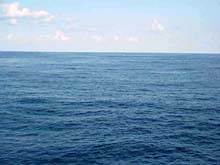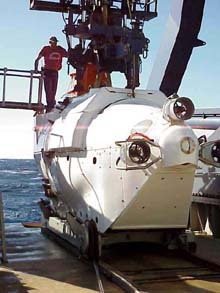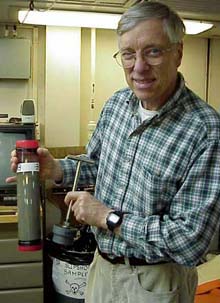
After spending a majority of the first leg of the Deep East expedition coping with 15+-ft seas, everyone aboard the R/V Atlantis is enjoying the pleasant weather during Leg 2 of Deep East. Click image for larger view.
Diving in the Deep Blue Sea
September 19, 2001
Holly Donovan, Teacher
Robert Hunter Elementary School
Flemington, NJ
"My soul is full of longing for the secret of the sea, and the heart of the great ocean sends a thrilling pulse through me."
--Henry Wadsworth Longfellow
The Sound of the Sea
Each successive day on the research vessel (R/V) Atlantis has brought warmer weather and calmer seas. Today, the ocean is almost glassily smooth, as the wind speed is down from 20+ knots on Monday to only 4 knots today. We are now rocking gently on soft swells, which makes the Alvin submersible's launch and recovery much easier for all concerned. Dr. Fred Grassle and Dr. Ken Able departed the ship in Alvin at 8:30 am for their dive to the head of Hudson Canyon. Calmer seas also make for a more relaxed atmosphere for both the crew and vistiors. All tasks can be accomplished more easily and efficiently when the ship is not hurtling from side to side!

A common source of bioluminescence in the pelagic zone include fish, squid, shrimp and jellyfish. Click image for larger view.
The Work of Research
When Alvin is out exploring, the shipboard scientists are checking samples or working on their computers. Those who were up for most of the night working on the box-core samples are sleeping, or napping off and on. Dr. Mary Scranton is in one lab testing and evaluating the water samples gathered by the CTD rosette on Monday night. She has her bottles, vials, and tubes set up and linked to an analytical gas chromatograph, which tests the gases released from the water when it is placed in a vacum. This machine will quantify the amount of methane found in samples taken at different depths of the water column. So far, her results indicate a higher level of methane near the ocean floor than she had expected.
Yesterday's Alvin dive had some navigational difficulties. Although it appeared that they were in the target area, the depths did not correspond, and the researchers found themselves in "shallower" water (2,627 m) than they had planned (about 2,650 m). As a result, the water samples they gathered will not supply data about methane levels in the deeper target area. Unfortunately, by the time the navigational problems were rectified, the sub didn't have enough battery power left to proceed to greater depths.
On each dive, scientists are gathering data and samples for others as well as themselves. This has included the collection of video footage, photos, four good box cores to be examined for evidence of living organisms, sediment cores to be checked for contaminant levels, water samples, and the striking giant anemone that Alvin hauled in yesterday.

Dr. Michael Bothner holds a sediment sample collected from Hudson Canyon. Click image for larger view.
The Dive on Hudson Canyon
In this section of the submarine canyon, the ocean floor was covered with fine sediment particles, making it look like a huge blizzard had coated the surface. Initially, the sediments were light gray, and later on, the gray was coated with a light brown veneer. The floor teemed with evidence of benthic life, in particular all kinds of worms. A variety of sediment-burrowing sea creatures had formed many small mounds, up to 1 m long and less than 1 m high. For the deep ocean, a surprising number and variety of fish were seen. Later, an icthyologist will be able to identify them from the video footage.
As the scientists explored, they passed over two large, presumably fiber-optic cables. Dr. Peter Rona stated that this area is an important hub for telecommunications, so it was not a surprising discovery. He pointed out that it is, therefore, important to understand the region's geology and to evaluate the stability of sediments on the continental slope. Shifting sediments or slumps could disrupt telecommunications.
Sign up for the Ocean Explorer E-mail Update List.
































